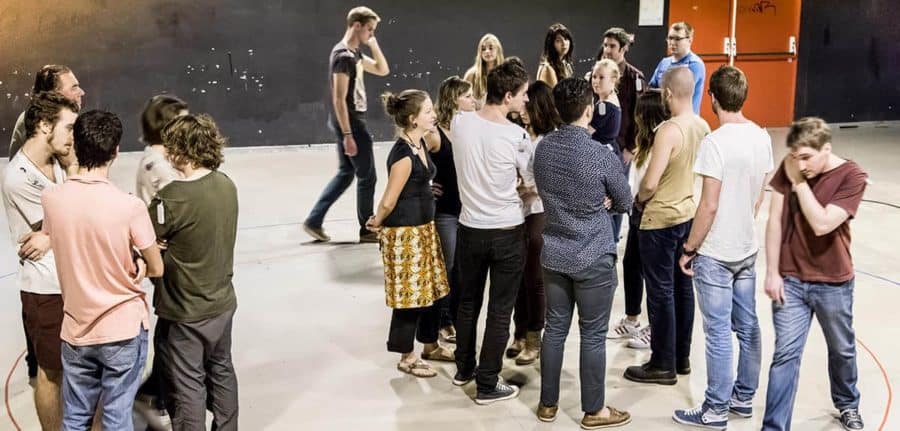Contrary to preconceived notions, crowds are hardly unpredictable. Researchers are perfectly capable of quantifying and modelling their movements. A few simple rules of individual behaviour – do not walk into walls, do not bump into fellow humans – are enough to produce a computer simulation of thousands of people walking within a space. However, when the individuals in this crowd are given an objective and some information, surprising and sometimes violent collective phenomena can suddenly happen, such as the wave in stadiums, the storming of the Capitol in Washington (US), and deadly stampedes.
For several years, the duo formed by Clément Sire, a physicist at the LPT,1 and Guy Théraulaz, an ethologist at the Research Center on Animal Cognition,2 both in Toulouse (southwestern France), have examined the phenomena at play when a large number of individuals, whether humans or animals, gather together and interact with one another. From schools of sardines to clouds of starlings or a crowd in the Underground, they try to work out the interactions and rules of behaviour that can explain the occurrence of self-organisation observed in these collectives. “We use the tools of statistical physics to model this demeanour. Once we have understood individual interactions, we can develop models and understand certain manifestations of collective intelligence observed in animal and human societies,” explains Théraulaz.
Understanding the link between information and organisation
The researchers are especially interested in communication within human and animal groups. “We try to quantitatively measure social interactions between individuals in order to understand the shared behaviour they give rise to,” adds Sire. They are trying in particular to identify what information alters the movements of these systems. In other words, what instructions or basic data must individuals exchange in order for these particular forms of organisation to emerge within these collectives.
In collaboration with colleagues from the Laboratory for Analysis and Architecture of Systems (LAAS) of the CNRS and the Toulouse School of Economics-Research (TSE-R),3 the scientists devised an original experiment that sheds lights on how information can lead groups of people to split into two. This enabled them to explore segregation, a behaviour that brings to mind physical phenomena such as the separation of oil and vinegar in salad dressing – and social ones such as segregation in cities or the polarisation of opinion on social media.
This trial brought together in an empty room a group of 22 volunteers (and was repeated with a total of more than 200 subjects). Each was assigned a colour, either red or blue; none of them knew their own colour, or that of others. Each volunteer wore a transmitter-receiver that followed their position in space in real time, and received signals from the computer operating the experiment.
The researchers asked each participant to walk around freely. The device beeped when the majority of a subject’s “vicinity” was from the opposite colour. The objective was simply to stop the beeping from the 22 volunteers: the experiment ended when everyone was surrounded by a majority of individuals from their own colour.
“The transmitter-receiver thus served as a sensory device, enabling participants to probe their environment, a little like an eye,” Sire explains. The instrument translated the volunteers’ surroundings into a binary signal: beep or silence. Without their knowledge however, the researchers controlled the precise nature of the “background” through a parameter they called “k”, namely the number of individuals required to trigger a beep in the volunteer’s immediate vicinity. Hence for k=3, the device beeped if two or three people among the closest three were from the opposite colour; for k=5, this ratio rose to at least three of the five closest. Through this variable, the “masters of the game” controlled the quantity of information provided to the cohort.
The results of the experiment came as a surprise to scientists, as the participants rather quickly found their own group and made the beeps stop. When someone’s device stopped beeping, they spontaneously stopped walking. Each time the experiment was recreated, the group split into blue and red sub-groups, whose number declined at the end of the trial when the value for k increased. However, from k=7, only two clearly separated sets of people usually formed. These results were accurately reproduced by a mathematical model in which the agents stopped walking when they no longer beeped.
“We showed that different collective behaviour could be elicited without the knowledge of those concerned, based on the quantity of information collected by the device,” Sire explains. By manipulating the value of k without telling the participants, the final number of groups was not the same.
Another remarkable factor, according to Théraulaz, was that “beyond a certain threshold, additional information did not alter the result”, which was clearly demonstrated when repeating the experiment. Indeed, beyond k=7, the behaviour of the collective remained the same, with almost perfect segregation into two groups. “This illustrates the notion of infobesity, as too much information is useless, and can even hinder joint performance,” he adds.
For Sire and Théraulaz, the group’s segregation into two colours is comparable to what can be observed on social media. “Polarisation on these platforms has become a major societal issue. Social networks create filter bubbles and echo chambers in which everyone thinks basically the same way,” Sire reminds. “Our experience shows that it is possible to control segregation within a group based on the information provided to individuals.” The polarisation observed on Twitter, Facebook and other networks is therefore neither a necessity nor an intrinsic characteristic of human groups, but rather a phenomenon that can be managed.
Reference: “Collective information processing in human phase separation,” B. Jayles, R. Escobedo, R. Pasqua et al., Philosophical Transactions of the Royal Society B375:20190801 (2020). https://doi.org/10.1098/rstb.2019.0801

